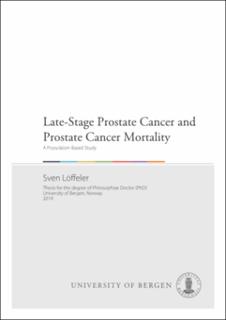| dc.contributor.author | Löffeler, Sven | en_US |
| dc.date.accessioned | 2020-02-18T10:23:55Z | |
| dc.date.issued | 2019-11-29 | |
| dc.date.submitted | 2019-10-31T07:47:43.018Z | |
| dc.identifier | container/94/1e/6b/5f/941e6b5f-eb82-4e56-bf03-023216dc3798 | |
| dc.identifier.isbn | 9788230844359 | en_US |
| dc.identifier.isbn | 9788230863909 | en_US |
| dc.identifier.uri | https://hdl.handle.net/1956/21427 | |
| dc.description.abstract | AIMS OF THE THESIS The aim of this thesis was to provide a better understanding of the final stages of PCa, metastatic castration resistant PCa and PCa death. We further aimed to address the consequences of possible undertreatment of elderly PCa patients. PATIENTS AND METHODS Paper I: The study was a retrospective analysis of a consecutive sample of patients with mCRPC seen at the urological unit of a local hospital from 2000 to 2005, their mCRPC diagnosis based on rising prostate-specific antigen (PSA) during androgen depletion treatment (ADT). Several easily accessible parameters were identified and their prognostic value was tested. Paper II: The study included all 764 patients from Vestfold County who had PCa and who died in 2009-2014. The true cause of death of all patients was evaluated based on patient medical records. Paper III: Retrospective analysis of 117 patient records (PCa death, Vestfold County, M0 at diagnosis, no radical treatment). Decision rationales at diagnosis with regard to treatment were identified. Local and systemic complications during the further course of the disease were registered. National data from the Cancer Registry of Norway (CRN, N=1874, ≥75 years at diagnosis, localized high-risk/ locally advanced PCa, WHO 0, diagnosed 2009-2017) were obtained and PCa specific survival was analyzed in patients who had received local treatment versus patients with no local treatment. RESULTS Paper I: Median overall survival for the entire cohort of mCRPC patients was 12.3 months (range 0.2-108 months), while 3-year survival was 16.9% (95% confidence interval 0.11-0.24). Two patients were alive at the end of follow-up. PSA doubling time following the onset of mCRPC, hemoglobin and alkaline phosphatase levels at the onset of mCRPC and PSA nadir during ADT prior to the onset of mCRPC were strong predictors of overall survival. Paper II: Over-reporting of PCa deaths in patients whose death certificate indicated that they died of PCa was 33% while under-reporting in the two groups who according to their death certificates died of other causes was 19% and 5%, respectively. The correlation between registered and observed causes of death was 0.81 (95% confidence interval 0.78-0.83). Misattribution of prostate cancer deaths increased significantly with patient age and decreasing Gleason score. Paper III: For the cohort of Vestfold patients age was the reason for choosing conservative treatment in 37% of patients (N=43), despite good health and functional status. Ninety percent of patients developed local complications attributable to PCa growth. National CRN data suggested a significant survival benefit for patients aged 75-79 years who had received local treatment. 5-year cause-specific survival of 98.9 percent (CI 96.7-99.7) compared to 90.8 percent in patients who had received no local treatment (CI 86.9-93.6). CONCLUSIONS Late stage PCa (mCRPC) is a heterogeneous condition with diverse survival. Its natural course can be defined by easily accessible parameters. PCa death reported on death certificates is unreliable particularly among the elderly and it is unsuitable as a stand-alone, population-based outcome measure in Norway. There are indications of undertreatment at diagnosis both in patients who later develop late-stage PCa and in patients who die of PCa and decisions with regard to radical treatment for patients with NMPCa are unduly influenced by patient age. The majority of elderly patients with high risk or locally advanced NMPCa who are not treated with local therapy suffer considerable local complications | en_US |
| dc.language.iso | eng | eng |
| dc.publisher | The University of Bergen | eng |
| dc.relation.haspart | Paper I: Löffeler S, Weedon-Fekjaer H, Wang-Hansen MS, Sebakk K, Hamre H, Haug ES, Fosså SD. "Natural course" of disease in patients with metastatic castrate-resistant prostate cancer: Survival and prognostic factors without life-prolonging treatment. Scandinavian Journal of Urology. 2015. 49(6):440-445. The article is not available in the thesis file due to publisher restrictions. The published version is available at: <a href="https://doi.org/10.3109/21681805.2015.1059881" target="blank">https://doi.org/10.3109/21681805.2015.1059881</a>. | en_US |
| dc.relation.haspart | Paper II: Löffeler S, Halland A, Weedon-Fekjær H, Nikitenko A, Ellingsen CL, Haug ES. High Norwegian prostate cancer mortality: evidence of over-reporting. Scandinavian Journal of Urology. 2018. 52(2):122-128. The article is available in the thesis file. The article is also available at: <a href="http://hdl.handle.net/1956/20286" target="blank">http://hdl.handle.net/1956/20286</a>. | en_US |
| dc.relation.haspart | Paper III: Löffeler S, Fawad H, Halland A, Beisland C, Haug ES. Non-metastatic prostate cancer: Rationale for conservative treatment and impact on disease related morbidity and mortality in the elderly. 2019. The article is not available in the thesis file. | en_US |
| dc.rights | In copyright | eng |
| dc.rights.uri | http://rightsstatements.org/page/InC/1.0/ | eng |
| dc.title | Late-Stage Prostate Cancer and Prostate Cancer Mortality : A Population-Based Study | en_US |
| dc.type | Doctoral thesis | |
| dc.date.updated | 2019-10-31T07:47:43.018Z | |
| dc.rights.holder | Copyright the Author. All rights reserved | |
| dc.contributor.orcid | https://orcid.org/0000-0002-3553-2491 | |
| fs.unitcode | 13-24-0 | |
| dc.date.embargoenddate | 2020-05-29 | |
